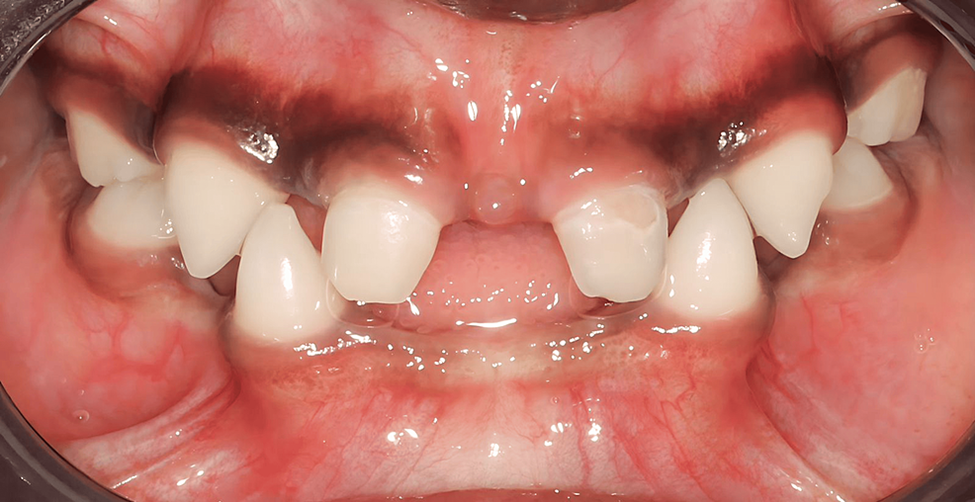Ectodermal dysplasia (ED) is a rare genetic disorder that manifests clinically with varying degrees of abnormality in multiple tissues. Common clinical presentations include hypotrichosis, hypohidrosis, and hypodontia. We report the case of a 5-year-old male patient who presented with these symptoms and was diagnosed with X-linked hypohidrotic ectodermal dysplasia (HED) type 1 based on clinical, radiographic, and genetic findings. While there is no available baseline data for this case, its presentation may alert dental practitioners and contribute to expanding scientific knowledge regarding this abnormality’s dental and oral characteristics.
Introduction 1
ED constitutes a rare group of genetic disorders impacting ectodermal derivatives, including skin, hair, nails, teeth, sweat, and salivary glands. Prevalence estimates suggest 1 in 100,000 live births, with approximately 150 ED forms. Classification based on sweat gland functionality categorizes ED into HED and hydrotic types. HED, the more prevalent form, exhibits X-linked, recessive, or autosomal dominant inheritance, characterized by hypodontia, hypohidrosis, and hypotrichosis. Genetic mutations in EDA1, EDAR, EDARADD, and WNT10A contribute to HED.
Etiology and Frequency 2
HED is a genetic disorder that is usually transmitted as an X-linked recessive trait. The female carries this gene and exhibits minimal expression in hypodontia, conical teeth, and sporadically reduced sweating. Males, on the other hand, may manifest the disorder. Carrier mothers have a 50% chance of passing the disease to their male children, while each female offspring has a 50% chance of inheriting the defective gene and becoming carriers. Sometimes, spontaneous gene mutation may occur in families without any previous history of the syndrome. The prevalence of HED in the population has been estimated to be between 1:10,000 and 1:100,000 male live births.
Mutating or deleting certain genes on different chromosomes can cause ectodermal dysplasia. Since it’s a genetic defect, it can be inherited and passed down through the family. In some cases, it can occur in people without a family history of the condition, in which case a de novo mutation has occurred. Mutations in the EDA, EDAR, and EDARADD genes cause HED. The X-linked form of HED (XLHED) is associated only with the EDA gene. 95% of people with HED have this form. The EDAR and EDARADD genes are known to be associated with both autosomal dominant and autosomal recessive forms of HED. Mutations in these genes account for 5% of HED.
Genetic Pathogenesis 2
The EDA, EDAR, and EDARADD genes produce proteins critical for ectoderm-mesoderm interactions during embryonic development. These interactions are essential for forming various ectodermal structures such as skin, hair, nails, teeth, and sweat glands. Mutations in these genes lead to defective protein formation and cause hypohidrotic ectodermal dysplasia, resulting in impaired development of hair, sweat glands, and teeth.
Case Presentation 1
At the Taibah University College of Dentistry, a five-year-old boy was brought to the dental clinic by his father. The patient’s chief complaint was missing teeth. During the extra-oral examination, the patient was found to have prominent frontal bossing, midface hypoplasia, sparse eyebrows, sparse hair, thick everted lips, large, low-set ears, thin, brittle nails, dry skin, and periocular hyperpigmentation. Additionally, the father reported that the patient experienced hypohidrosis during physical activity. However, the patient did not report any vision or hearing issues.
During the intra-oral examination, it was discovered that the patient suffered from oligodontia, with only primary maxillary central incisors, maxillary and mandibular primary canines, and primary second molars present. A low salivary gland was also noted, although the patient did not complain of xerostomia. A panoramic X-ray was taken, revealing multiple missing teeth buds.

Figure 1: Frontal and profile photograph showing frontal bossing, midface hypoplasia, sparse brows, thick everted lips, big, low-set ears, and periocular hyperpigmentation
After conducting genetic testing, the patient was diagnosed with X-linked hypohidrotic ectodermal dysplasia type 1 based on the clinical and radiographic features. The genetic testing was performed at King Faisal Specialist Hospital using whole-exome sequencing (WES) + copy number variant (CNV). The patient was advised to maintain their current dentition by following oral hygiene instructions and periodic topical fluoride applications. The option of upper and lower partial dentures was presented to the patient, but they refused this treatment at the current time. However, they agreed to an implant treatment plan in the future after the completion of craniofacial growth.

Figure 2: Intraoral photograph showing oligodontia (only primary maxillary central incisors, primary canines, and primary second molars present)

Figure 3: Panoramic X-ray reveals multiple missing teeth along with a few developing buds of permanent teeth
Discussion 1
This study aims to highlight an uncommon ED in Madinah’s population and improve its diagnosis and identification. ED is a genetic disorder affecting the growth of two or more ectodermal derivatives, such as hair, teeth, nails, and special glands. Hypohidrotic ED is its most common type, characterized by missing teeth, inability to sweat, and thin, light-colored hair. Diagnosis is based on clinical characteristics, family history, and genetic testing. Treatment options include prosthetic devices, dental implants, and sweat gland surgery. A multidisciplinary team of healthcare providers must collaborate for comprehensive prosthetic treatment planning. Oral rehabilitation is critical for ED patients to restore their health and self-esteem.
Conclusion 1,2
Ectodermal dysplasia is a rare genetic condition that primarily affects the development and growth of tissues originating from the embryo’s outermost layer (ectoderm). The disease can manifest as reduced hair growth (hypotrichosis), decreased ability to sweat (hypohidrosis), or fewer-than-normal teeth (hypodontia), among other symptoms. Diagnosis is usually based on clinical observations and, when feasible, genetic testing. Treatment focuses on managing symptoms and addressing the needs of the affected individual.
References
- Zaki H. Rare Pediatric Genetic Case Report of X-linked Hypohidrotic Ectodermal Dysplasia Type 1. Cureus. 2023 Dec 2. doi:10.7759/cureus.49840
- Deshmukh S, Prashanth S. Ectodermal dysplasia: a genetic review. Int J Clin Pediatr Dent. 2012 Sep;5(3):197-202. doi: 10.5005/jp-journals-10005-1165.







